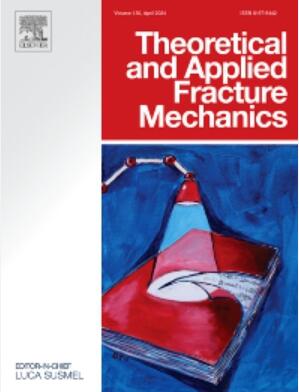An experimental study of fracture mechanism and morphology of granite specimens under various dynamic loading rates
IF 5.6
2区 工程技术
Q1 ENGINEERING, MECHANICAL
引用次数: 0
Abstract
Numerous studies have shown that dynamic fracture toughness (DFT) of rock is dependent on loading rate. This paper quantitatively studied the effect of loading rate on DFT from perspective of mesoscopic fracture morphology. First, notched semi-circle bend (NSCB) and short-core-in-compression (SCC) samples of granite were prepared for dynamic mode I and mode II fracture tests. Then, the DFT values of NSCB and SCC specimens at various loading rates were calculated and analyzed. After that, mesoscopic morphologies of failure surfaces of NSCB and SCC specimens under various loading rates were obtained by scanning electron microscope (SEM). The fracture morphology features of specimens were quantitatively characterized by a method combining deep learning and SEM images. The analytical results suggested that as loading rates rose, the increase in the percentage of mesoscopic fracture morphology caused by shear stress (MFM-S) on the fractured surface was the primary reason for the increase of DFT. When dynamic loading varied from 40 to 120 GPa m1/2 s−1, there was a linear relationship between the DFT and the proportion of MFM-S. Additionally, with an increasing loading rate, the proportion of MFM-S on the fracture surface of NSCB specimens varied slightly more, which can explain why the dependence of DFT on loading rate in NSCB specimens was somewhat more obvious than in SCC specimens.
不同动态加载速率下花岗岩试样断裂机理和形态的实验研究
大量研究表明,岩石的动态断裂韧性(DFT)与加载速率有关。本文从中观断口形态的角度定量研究了加载速率对动态断裂韧性的影响。首先,制备了花岗岩的缺口半圆弯曲(NSCB)和短芯压缩(SCC)样品,进行动态模式 I 和模式 II 断裂试验。然后,计算并分析了 NSCB 和 SCC 试样在不同加载速率下的 DFT 值。然后,利用扫描电子显微镜(SEM)获得了不同加载速率下 NSCB 和 SCC 试样断裂表面的中观形貌。通过深度学习和扫描电镜图像相结合的方法,对试样的断裂形态特征进行了定量表征。分析结果表明,随着加载速率的增加,断裂表面由剪应力引起的中观断裂形态(MFM-S)百分比的增加是 DFT 增加的主要原因。当动态加载从 40 GPa m1/2 s-1 到 120 GPa m1/2 s-1 变化时,DFT 与 MFM-S 的比例呈线性关系。此外,随着加载速率的增加,NSCB 试样断裂面上的 MFM-S 比例变化略大,这可以解释为什么 NSCB 试样的 DFT 对加载速率的依赖性比 SCC 试样更明显。
本文章由计算机程序翻译,如有差异,请以英文原文为准。
求助全文
约1分钟内获得全文
求助全文
来源期刊

Theoretical and Applied Fracture Mechanics
工程技术-工程:机械
CiteScore
8.40
自引率
18.90%
发文量
435
审稿时长
37 days
期刊介绍:
Theoretical and Applied Fracture Mechanics'' aims & scopes have been re-designed to cover both the theoretical, applied, and numerical aspects associated with those cracking related phenomena taking place, at a micro-, meso-, and macroscopic level, in materials/components/structures of any kind.
The journal aims to cover the cracking/mechanical behaviour of materials/components/structures in those situations involving both time-independent and time-dependent system of external forces/moments (such as, for instance, quasi-static, impulsive, impact, blasting, creep, contact, and fatigue loading). Since, under the above circumstances, the mechanical behaviour of cracked materials/components/structures is also affected by the environmental conditions, the journal would consider also those theoretical/experimental research works investigating the effect of external variables such as, for instance, the effect of corrosive environments as well as of high/low-temperature.
 求助内容:
求助内容: 应助结果提醒方式:
应助结果提醒方式:


